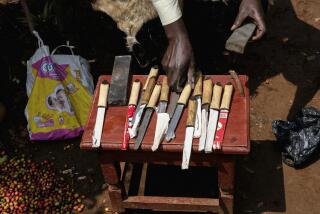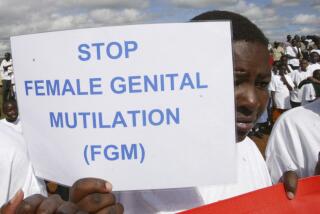Female Circumcision Triggers Debate on Rites Versus Rights
- Share via
HARGEISA, Somalia — Hudan Mohammed Ali’s shrieks for Allah’s mercy rend the dawn and chill the heart. Her sister smacks Hudan’s face and holds her in position as an old woman cuts deeper into the 6-year-old’s flesh.
Three women struggle to pin the writhing child to a short stool stained with the blood of a thousand other little girls who before her were forced to submit to the ancient rite of female circumcision--the ritual cutting of a girl’s genitals.
“I must get rid of the dark flesh,” says Halimo Mohamoud Obahleh, Hudan’s great aunt and a “gudniin,” or traditional circumciser.
*
The World Health Organization estimates that up to 120 million women alive today in at least three dozen countries have been circumcised. UNICEF says most girls are between the ages of 4 and 10 when they undergo the rite.
Critics call it female genital mutilation, a way for men to curb a woman’s sexual pleasure and jealously guard her chastity. Westerners condemn it as torture, child abuse and a violation of human rights.
Many women suffer infections, difficult childbirth and even death as a result of circumcision.
The United States’ highest immigration court on June 13 granted a West African teenager asylum because she feared genital mutilation if she was forced to return to Togo.
But it is a revered rite of passage in parts of Africa, the Middle East and Southeast Asia. Immigrants are taking the practice with them to Europe, Australia, Canada and more recently America.
In practicing countries, women who are not circumcised are considered less desirable or even prostitutes. Often, a virgin brings a higher bride price or dowry. The greatest insult in Somalia is “son of an uncircumcised mother.”
The procedure can simply be a small but painful nick across the hood of the clitoris.
But it is typically more severe: The clitoris, the organ of sexual pleasure in women, is removed.
In a method called infibulation, the clitoris, inner labia and most of the soft flesh of the labia majora are scraped or cut away. The two sides of the vulva are then fastened with acacia thorns, catgut, silk or a glue made from a tree gum or eggs.
*
Almost all Somali women are circumcised, and Hudan is among the 87% who undergo the most severe type--infibulation. Until now, Hudan has wanted the procedure so that she will be like other girls.
Her fingers slowed by age, Mohamoud Obahleh tugs at the girl’s clitoris, then slices off the flesh with a double-edged razor. Blotting away blood, she amputates the labia minora, wiping the bits of flesh off on the girl’s trembling thigh.
“It hurts, it hurts, it hurts,” Hudan howls, in excruciating pain despite the rough injection of a local anesthetic bought from a hospital. “You’re all against me. Stop! Now!”
Flies feast on the blood pouring from her wounds.
Grandmother Fatuma Ismail Mohamoud admonishes her to be silent--her cries ringing from a relative’s ramshackle house will bring shame on the family. “It’s nothing, it’s nothing,” she says. “You wanted it so badly, now you have it.”
With a thick sewing needle and heavy black thread, Mohamoud Obahleh sews the raw flesh together with five crude stitches to fashion a chastity belt of the girl’s own flesh to make sex impossible until she is married and her husband cuts or tears her open.
The rail-thin child is then bound from waist to toes, and she will remain tied for weeks until scar tissue nearly seals the vagina. She is left with just a pencil-thin hole close to the anus for urination and menstruation.
*
The most frequent reason offered for female circumcision is to stifle a girl’s desire for sexual intercourse and to make penetration impossible, thereby preserving her chastity.
“If you don’t cut this part, she will be a harlot. She will run away and find men,” said Abdulcadiar Abdullahi, the 85-year-old father of two girls who were recently infibulated.
Discussing Hudan’s circumcision, Mohamoud Obahleh said: “The only value of a girl is her virginity. The main thing is to protect the girl, to protect her from men, until she is married.”
Ibrahim Aadan, 18, said he would only marry a woman who had been infibulated. “Otherwise, I would be very jealous. I want a clean, untouched woman,” he said.
Because marriage is an economic necessity in countries where circumcision is prevalent, the ritual is “seen as an act of love, rather than one of cruelty,” said Dr. Mohammed Haddi, an obstetrician and gynecologist.
But infibulation is no guarantee of virginity. At the Hargeisa orphanage, 40 of the 110 children were abandoned by their unwed, circumcised mothers who were cut or torn open, willingly or unwillingly, by the men who impregnated them.
*
Efua Dorkenoo, the World Health Organization’s expert on female circumcision based in Geneva, said genital mutilation is closely linked with poverty, illiteracy and low status of women.
Among its strongest proponents are the midwives and barbers who perform the act with a razor, scissors or a shard of glass.
Mohamoud Obahleh, her sister and daughter are members of the Muse Dhariye sub-clan, the equivalent of the “untouchables” in India, and traditionally have been allowed only the lowest tasks in Somali society.
They sell spices from a dirty patch at the central market, but most of their income comes from performing circumcisions. They charge 5,000 shillings--about $3--a girl. Others charge as much as $55.
There are aesthetic concerns besides the issue of sexuality, Mohamoud Obahleh said, sounding rather like a Western woman endorsing a breast enlargement or a tummy tuck. “A woman’s external genitalia are unattractive, so it it better to remove them so she is more beautiful.”
Many cultures believe that unless the clitoris is removed, it will secrete foul-smelling fluids and grow so long that it touches a woman’s thighs.
*
No one knows exactly when or how the practice began, though scholars speculate it originated along the Nile Valley. The earliest literary references, dating from 2000 B.C., indicate that ancient Egyptians, Jews and others performed the surgery.
Some scholars believe nomads invented infibulation, cutting and sewing closed the vaginal opening, to keep female herders monogamous and to protect them from rape. Other have suggested it may be a primitive form of population control, perhaps imposed by slave owners who did not want their women unable to work.
In the West, doctors amputated clitorises and ovaries in the 19th century as a treatment for epilepsy, hysteria, lesbianism, masturbation, melancholia and nymphomania. As recently as the 1950s, American and European doctors performed clitoridectomies to treat nymphomania and melancholia.
Although female circumcision is not prescribed in the Koran, it is most commonly practiced by Muslims. But the practice does not exist in Saudi Arabia, home to many of the holiest places of the Islamic world, or in many other Muslim countries, including Algeria, Iraq, Syria and Tunisia.
“There is no evidence that the Prophet Muhammad ordered the circumcision of his own daughters,” Ibrahim Ahmed Hussein, a prominent Islamic leader in Hargeisa, said in an interview.
“For women, it is sufficient to just make a very small cut in the hood of the clitoris. Cutting and sewing is nothing to do with Islam,” he said.
*
Hudan had her own reasons for wanting to be circumcised.
“Other children tease me because I haven’t been cut,” she said two days before undergoing the procedure. “If girls are not circumcised, they will be insulted. If they are insulted, they will not be beautiful.”
Hours after being circumcised, having recovered from the initial shock and pain, Hudan smiles proudly at her rite of passage.
“I am happy now,” the girl says, her sweet face brushed with the golden pulp of a tree bark, a cosmetic used by Somali women to keep their skin soft.
She is fed only sticky white rice to keep her stools soft, and is allowed just one cup of tea a day. She has yet to feel the pain of passing urine that will burn like fire until the wounds heal.
When her legs are unbound in up to 40 days, her childish gait will have become a shuffle.
It may take her a quarter hour to urinate, drop by drop. And she may have a kidney or bladder infection.
When her menstrual periods start, they will last 10 days and she will be incapacitated by cramps nearly half the month caused by the near impossibility of flow passing through so tiny an opening. The odor of soured blood will linger.
If the wound heals improperly, shiny keloid scars will crisscross the otherwise soft tissue of the vulva. Childbirth will be difficult, and the thick scars may have to be cut through to the rectum.
“Women who deliver end up ripped to pieces,” said Haddi, the obstetrician.
*
The risk of maternal death is doubled by circumcision and the risk of a stillbirth increase several fold, the World Health Organization says.
If the labor is long and difficult, the pressure of the fetus’ head may cause fistulas, abnormal openings. Unless the damage is repaired, urine or feces may leak into the vagina, then seep uncontrollably down a woman’s legs.
Many women are unaware that their long-term health problems result from circumcisions. Layla Ibrahim, 27, who suffered severe infections after she was infibulated, knows.
“I’ve had constant pain through my lower abdomen,” she said. “I find no pleasure in sex. When my husband tries to penetrate me, I cry out in pain. My neighbors know what’s going on. It’s embarrassing.”
*
Hargeisa is the capital of the self-declared independent Republic of Somaliland in northwestern Somalia. Its government, with the support of UNICEF, is trying to eradicate female circumcision by 2000.
At a recent workshop, participants recommended that education about harmful effects of female circumcision be part of the school curriculum and that the government and religious leaders spread the word that it is against Islamic law and thus sinful.
“This is a long-lasting tradition and it will be difficult to change. But we must do it,” said Ahmed Hashi Nur, director general of the Ministry of Health and Labor.
Erasmus Morah, UNICEF project officer in Hargeisa, said the time for change is now--after a decade of war destroyed institutions and the social fabric of Somaliland.
To his surprise, men are the most willing to change, Morah said. “The hardest of soldiers are sickened when they see the pain this causes their daughters.”
Mohamoud Abdillahi, a government official, said his daughters will not be infibulated, but as an act of faith will simply be cut to draw blood from the clitoris hood.
Recalling the agony of hearing his 6-year-old sister “screaming out for me” when she was circumcised, Abdillahi said that “I swore that would never be done to my daughters.”
But such sentiments are no match for the relentless pressure of tradition.
“We can’t win,” said Rakiya Abdi, 32. “If we circumcise our daughters, there is pain. If we don’t circumcise our daughters, there is different pain. The community will not accept us.”
*
Society’s approval is powerful.
Hudan, who lost her father to death in the war and has not seen her mother since she fled the fighting, is pleased by the rare attention her surgery brings her.
In a richer family, a circumcision would have been celebrated with a feast and gifts.
Hudan smiles. “I’m a big girl now. Just like my friends.”
More to Read
Sign up for Essential California
The most important California stories and recommendations in your inbox every morning.
You may occasionally receive promotional content from the Los Angeles Times.













